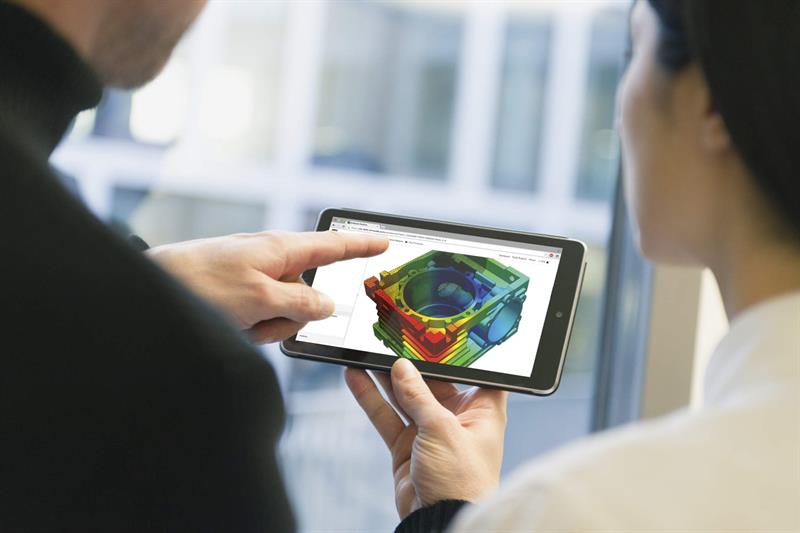A powerful, cloud-based CAE platform supporting multiple simulation types including solid mechanics, fluid dynamics and thermodynamics, Simscale requires no specialised local hardware, software or licenses. A standard web browser and broadband internet connection are sufficient to set up and run a numerical simulation, having access to a fully-fledged high-performance computing-powered simulation environment.
Since its official launch in Munich in 2013, SimScale has prided itself on challenging the ‘status quo’ of the traditional CAE software market by offering a fully cloud-based engineering simulation solution with zero hardware and software footprint, available at a fraction of the price of its competitors.
The SimScale platform is completely accessible via a standard web browser, with an easy-to-use interface that supports numerous simulation types including: structural mechanics, fluid dynamics, thermodynamics, acoustics, and particle phenomena.
By harnessing the power of the cloud for simulation, SimScale, it is claimed, eliminates the hurdles that accompany traditional simulation tools such as high installation costs, licensing fees, deployment of high-performance computing hardware, required updates and maintenance.
By the nature of the service, users always have the latest version of SimScale. With the SimScale community, all users have free access to hundreds of simulation projects. From beginners to advanced users, the community is a place for ‘crowdsourcing’ simulation knowledge and collaboration.
Individuals, small businesses, and large enterprises worldwide have introduced SimScale into their workflow to test and validate preliminary designs virtually rather than using costly physical prototyping. The ‘pay-as-you-go’ nature of the service can mean that the rewards involved in using the service can often be far in excess of the costs.
 A good example of this can be seen in the experience of Carlsson Autotechnik, which – among other things – develops and sells grafting programmes for Mercedes-Benz vehicles. While large automobile companies obviously maintain a number of development departments with their own test stations for engine, chassis and body development, Carlsson is facing the challenges of managing the same tasks with limited resources. Playing a vital role in the automotive industry and especially in structural stress optimisation, aerodynamics, and cooling, engineering simulation can remove technology barriers.
A good example of this can be seen in the experience of Carlsson Autotechnik, which – among other things – develops and sells grafting programmes for Mercedes-Benz vehicles. While large automobile companies obviously maintain a number of development departments with their own test stations for engine, chassis and body development, Carlsson is facing the challenges of managing the same tasks with limited resources. Playing a vital role in the automotive industry and especially in structural stress optimisation, aerodynamics, and cooling, engineering simulation can remove technology barriers.
However, using SimScale’s pay-as-you-go model, Carlsson’s team was able to use the simulations for everything it needed, paying only for what they used. Due to its browser-based deployment of software, computing capacity and data management, the SimScale platform enabled the engineers to do a flexible implementation of the whole simulation array without high fixed investments.
On the basis of the simulation results, it was possible for Carlsson’s engineers to examine and optimise the aerodynamics of the vehicle. Besides the resulting forces for air drag and downforce – or rather the related dimensionless benchmarks that are calculated automatically – there are various physical quantities available in the entire flow domain, such as pressure, velocity, and turbulence. These can be visualised as desired with cuts and streamlines and subsequently saved as image files. In contrast to wind tunnel tests, the impact of a changed design could not only be quantified but also investigated in detail.
To give some idea of the cost-effectiveness of this solution, the overall cost of this simulation to Carlsson was just €60 and the simulation time was five hours.
“Our vision at SimScale is to enable every designer and engineer to take full advantage of engineering simulation — independent of budget, hardware and know-how,” says David Heiny, CEO of SimScale.
The latest development of SimScale integrates both Siemens’ Parasolid software and Tech Soft 3D’s HOOPS Exchange to enable a more convenient and seamless simulation workflow, while at the same time further increasing simulation result accuracy — both in FEA and CFD.
Parasolid is the industry-leading 3D geometric modelling component for computer-aided design, manufacturing and engineering analysis (CAD/CAM/CAE) solutions, while HOOPS Exchange is the leading CAD translation software development kit (SDK).
The developers behind SimScale say this double integration will enable a more convenient and seamless simulation workflow, also increasing simulation result accuracy both in FEA and CFD. All processes can take place within a web browser, making simulation as simple as possible with zero hardware and software footprint.
“This latest implementation of Parasolid in a cloud-based application will enable engineers to simulate, test and modify 3D models using only a web browser,” says Jim Rusk, chief technology officer, Siemens PLM Software. “In selecting Parasolid, Simscale also obtains translation-free interoperability with hundreds of other applications that integrate Parasolid to design, edit and exchange high-precision 3D models based on the Parasolid XT data format.”



